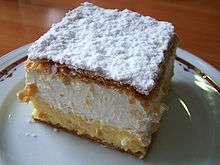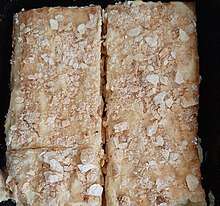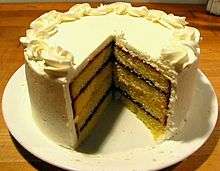Cremeschnitte
A cremeschnitte (German: Cremeschnitte, Hungarian: krémes, Polish: kremówka, Romanian: cremșnit, cremeș, crempita, Serbian: krempita/кремпита, Croatian: kremšnita[2], Slovak: krémeš, Slovene: kremna rezina, kremšnita) is a vanilla slice or custard slice, a custard and chantilly cream cream cake dessert originating from the Austro-Hungarian Monarchy but whose exact origin is unknown.
 | |
| Alternative names | Hungarian: krémes, Polish: kremówka, Romanian: cremșnit, cremeș or crempita, Serbian: krempita/кремпита, Croatian: kremšnita[1], Slovak: krémeš, Slovene: kremna rezina, kremšnita |
|---|---|
| Course | Dessert |
| Place of origin | Europe |
| Main ingredients | Puff pastry, chantilly and custard cream |
| Variations | Kremna rezina, Samoborska kremšnita, Zagrebačka kremšnita |
.jpg)
This dish is popular in many former Austro-Hunagrian regions in various variations, all of which include a puff pastry base and custard cream, including the following countries:
By country
In Austria
In Slovenia
In Slovenia, kremna rezina is commonly associated with the town of Bled, an Alpine tourist destination in northwestern Slovenia. The recipe cake was brought to the local Hotel Park in 1953 by Ištvan Lukačević , chef of the hotel's confectionery store. He came to Bled from Serbia where a similar cake was already known. As of October 2009, 10 million cream cakes have been baked at the hotel's patisserie since its invention.[3][4][5] The name of the dessert means simply "cream slice". Most locals refer to it as kremšnita, from the German word Cremeschnitte, with the same meaning. While the kremna rezina from Bled celebrated their 10th million piece production, Slaščičarna Lenček, which is located in Domžale, in year 2013 celebrated the 75th anniversary since they have made their first one which is called Lenčkova kremna rezina.
In Croatia
In Croatia, the two most popular variants are Samoborska kremšnita from the town of Samobor and Zagrebačka kremšnita from the capital, Zagreb. The extremely popular Samoborska kremšnita is characterized by having a puff pastry top, predominantly custard cream filling (less whipped cream) with meringue and is finished with powdered sugar. Zagrebačka kremšnita has a characteristic chocolate icing instead of the puff pastry top, while maintaining the puff pastry base. The classic recipe for Samoborska kremšnita is considered to be designed by Đuro Lukačić in the early 1950s, based on different earlier variants found in patisseries of Zagreb.[6]
In Serbia, Bosnia and Herzegovina, and Montenegro

In Serbia, Bosnia and Herzegovina, and Montenegro, the dish is known as krempita 'cream pie'. It is usually prepared with puff pastry dough.[7] The filling is usually pure thick custard, less commonly combined with meringue (whipped egg whites and sugar) creme. A similar recipe with only meringue filling is called Šampita.
In Poland
In Romania
Is made out of filo pastry of usually three layers with cream on top and crumble sprinkled on it.

In Australia
In Australia, the dish is more commonly known as a 'vanilla slice', or a 'snot block'.
In New Zealand
In New Zealand, this dish is known as 'custard slice' where it has a puff pastry bottom, custard, puff pastry top and topped with vanilla icing or plain icing sugar.
References
- "Hrvatski jezični portal - Kremšnita". Retrieved 25 April 2020.
- "Hrvatski jezični portal - Kremšnita". Retrieved 25 April 2020.
- "Bled: praznovanje ob 10-milijonti kremni rezini" (in Slovenian). RTV Slovenia. 2009-10-10. Retrieved 2011-01-01.
- "Deset milijonov originalnih blejskih kremnih rezin" (in Slovenian). Dnevnik Newspaper. 2009-10-12. Retrieved 2011-01-01.
- "Na Bledu praznujejo desetmilijonto kremšnito" (in Slovenian). Večer Newspaper. 2009-10-10. Retrieved 2011-01-01.
- "Archived copy". Archived from the original on 2012-05-25. Retrieved 2012-02-01.CS1 maint: archived copy as title (link)
- Rolek, Barbara. "Serbian Custard Slice Recipe - Krem Pita". About.com: Eastern European Food. Retrieved 8 May 2012.
